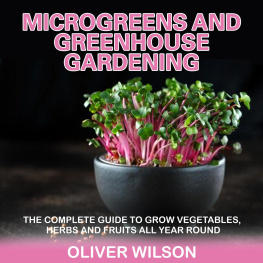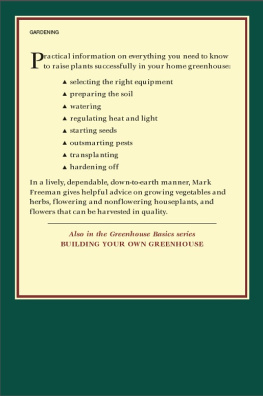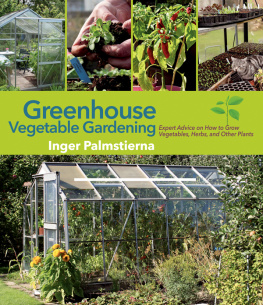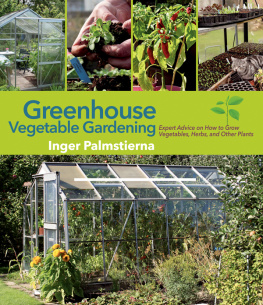Microgreens
And
Greenhouse Gardening
(2 Books in 1)
MICROGREENS

The Complete Guide to Indoor Gardening, How to Grow Nutrient-Packed Greens and Hydroponic Grows
Oliver Wilson
Copyright 2020 by Oliver Wilson
All rights reserved.
This document is geared towards providing exact and reliable information with regards to the topic and issue covered. The publication is sold with the idea that the publisher is not required to render accounting, officially permitted, or otherwise, qualified services. If advice is necessary, legal or professional, a practiced individual in the profession should be ordered.
- From a Declaration of Principles which was accepted and approved equally by a Committee of the American Bar Association and a Committee of Publishers and Associations.
In no way is it legal to reproduce, duplicate, or transmit any part of this document in either electronic means or in printed format. Recording of this publication is strictly prohibited and any storage of this document is not allowed unless with written permission from the publisher. All rights reserved.
The information provided herein is stated to be truthful and consistent, in that any liability, in terms of inattention or otherwise, by any usage or abuse of any policies, processes, or directions contained within is the solitary and utter responsibility of the recipient reader. Under no circumstances will any legal responsibility or blame be held against the publisher for any reparation, damages, or monetary loss due to the information herein, either directly or indirectly.
Respective authors own all copyrights not held by the publisher.
The information herein is offered for informational purposes solely, and is universal as so. The presentation of the information is without contract or any type of guarantee assurance.
The trademarks that are used are without any consent, and the publication of the trademark is without permission or backing by the trademark owner. All trademarks and brands within this book are for clarifying purposes only and are the owned by the owners themselves, not affiliated with this document
TABLE OF CONTENTS

S
ince their introduction into the Californian restaurant arena from the 1980s, microgreens have steadily gained recognition.
All these aromatic greens, also referred to as micro vegetable or herbs confetti, are full of taste and add a welcome splash of colour to many different dishes.
Despite their dimensions they pack a nutritional punch, so frequently comprising higher nutrient levels compared to adult vegetable greens. This makes them a pretty fantastic addition to any diet program.
This article reviews the possible health advantages of microgreens and supplies a step-by-step guide about the best way best to increase your own.
Which are microgreens?
Microgreens are youthful vegetable greens which are roughly 13 in. (2.57.5 cm) tall.
They've an aromatic taste and focused nutrient material and come at a variety of shades and textures.
Microgreens are believed baby crops, falling somewhere between a sprout and baby.
Nevertheless, they should not be mistaken with sprouts that don't have leaves. Sprouts have a lot shorter growing cycle of twoseven times, whereas microgreens are generally chosen 721 days after germination, when the plant first true leaves have surfaced.
Microgreens are more like baby greens because their stalks and leaves are deemed edible. But unlike baby greens, they are far smaller in size and could be marketed prior to being chosen.
This means that the crops could be purchased whole and cut home, maintaining them alive till they are absorbed.
Microgreens are extremely convenient to develop, as they can be developed at a variety of places, including outside, in greenhouses and on your windowsill.
Overview microgreens are youthful vegetable greens which fall somewhere between baby and sprouts leaf lettuce. They've an intense aromatic taste and focused nutrient material and come in various shades and textures.
Different kinds of microgreens
Microgreens could be increased from several distinct kinds of seeds.
The most well-known varieties are made with seeds in the next plant households:
- Brassicaceae household: cauliflower, cabbage, broccoli, watercress, radish and arugula
- Asteraceae household: lettuce, endive, chicory and radicchio
- Apiaceae household: dill, lettuce, celery and fragrant
- Amaryllidaceae family: garlic, onion, leek
- Amaranthaceae household: amaranth, quinoa swiss chard, beet and lettuce
- Cucurbitaceae family: melon, pineapple and pineapple
Cereals like cheese, rice, corn, wheat and barley, in addition to legumes like chickpeas, lentils and legumes, are also occasionally developed to microgreens.
Microgreens change in flavor, which may vary from neutral to hot, slightly sour or bitter, based upon the number. Broadly, their taste is deemed powerful and focused.
Overview microgreens could be increased from assorted seeds. Their flavour may fluctuate greatly based on the number.
Microgreens are nutritious
Microgreens are packed with nourishment.
Even though their nutrient contents change slightly, most types tend to be wealthy in potassium, magnesium, iron, magnesium and aluminium.
Microgreens are also a fantastic source of valuable plant chemicals like antioxidants.
What is more, their nutrient material is more focused, meaning that they often include higher vitamin, mineral and antioxidant levels compared to the exact same amount of adult greens.
Research comparing microgreens to mature greens accounts that nutrient amounts in microgreens could be up to eight times greater than those seen in older greens.
Research also demonstrates that they feature a wider assortment of polyphenols and other antioxidants in their adult counterparts.
1 study measured antioxidant and vitamin levels in 25 commercially accessible microgreens. These amounts were compared to amounts listed in the USDA national nutrient database for older leaves.
Though antioxidant and vitamin levels diverse, amounts measured in microgreens were around 40 times greater than those listed for more adult leaves.
Nevertheless, not all studies report similar outcomes.
For example, 1 study compared nutrient amounts from carrots, microgreens and fully-grown amaranth plants. It noted the completely grown crops frequently comprised as much, or even more, more nutrients compared to microgreens.
Accordingly, though microgreens generally seem to include higher nutrient amounts than more mature crops, this could vary dependent on the species in hand.
Overview microgreens are full of nutrients. They frequently contain larger quantities of vitamins, antioxidants and minerals compared to their mature counterparts.
Next page

















